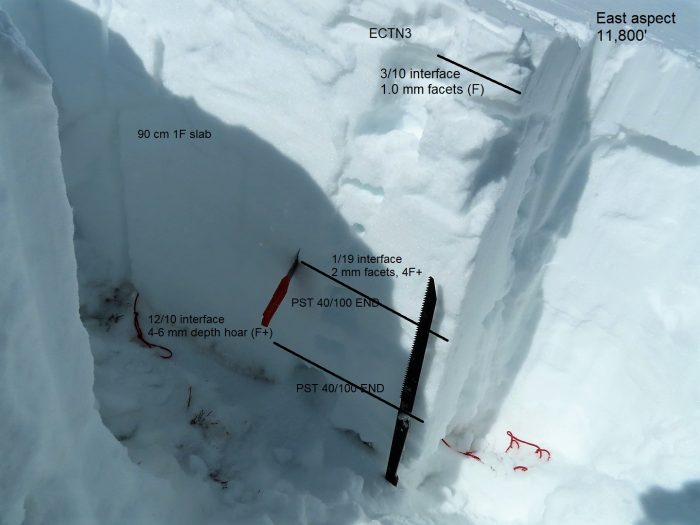An update on our persistent slab problems. March 16, 2021. By Zach Guy, Lead Forecaster
You will notice in our forecasts a change in travel advice, size, and likelihood of the persistent slab problem – a problem that has been on the bulletin all winter. We have several persistent weak layers in the snowpack, and we are restructuring how to present them as avalanche problems as we move forward this week. As much as we’d like our problems to fit into a nice, clean box, often the snowpack blends problems and blurs the lines. Our goal is always to make clear and simple travel advice using avalanche problems as a foundation. For that reason, here are the changes you can expect as our snowpack evolves.
- We have a new persistent slab problem that is just starting to evolve, the result of weak layers that formed in late February and early March. It has been the culprit in a handful of triggered slides in the past week, including a few remote triggers (example A, example B). Up until now, we’ve been calling it a storm slab or wind slab in our problem list. The problem isn’t well developed yet because we simply haven’t had much snow on these layers yet. You can find it now in areas where the winds have loaded snow, or in areas that got more snow out of this last storm. The weak layers of concern were most recently buried on March 10th, so we’re calling it the 3/10 weak layer. It is actually a stack of weak layers that formed throughout the dry spell that started in mid-February, that was interrupted by a few small snowfall events and warmups in early March. Thus, it presents itself as either a crust/facet/crust layer or near-surface facets, or some combination of the two. It is especially weak where it formed on the bed surfaces of avalanches that ran in mid-February (and there were a lot of avalanches in mid-February). That’s because the snowpack on those slopes is shallower and more prone to advanced faceting. So far, we’ve only found it to be a concern on northwest, north, northeast, and east aspects. That’s because the facets got cooked on hotter slopes and/or the crusts are thicker and stronger on those more southerly aspects. The photo below demonstrates what that problem looks like near Kebler Pass right now.

- We are phasing our old persistent slab problem off of the problem list – and by that, we mean the large-grained weak layers near the ground that formed early in the season (The 12/10 layer and 1/19 layer). Apart from wet slab issues, which are a different beast, those layers have been dormant since late February. This last storm was a modest test on deep layers and we didn’t see evidence of them becoming an issue again. This problem has been a blend of a persistent slab or deep persistent slab since February, depending on your location in the forecast area and what aspect you are on. We kept calling it a persistent slab across our forecast zone for simplicity’s sake. If we reintroduce this problem later in the spring due to a major storm, we will likely be listing it as a deep slab problem, to prevent overlapping and confusing travel advice for the newer generation of persistent slabs. We are phasing it out as one of the primary problems because triggering one of these deeper layers has become very unlikely under our current weather pattern. That could certainly change with future storms, and it is impossible for us to completely rule out an oddball avalanche that breaks on deep layers. The most probable scenario for a deep failure would be a large cornice fall. Of course, basal weak layers could also reemerge as a problem during spring melt, in which case we’ll present them as a wet slab problem. The image below shows an example of the 12/10 and 1/19 layers on Mt Whetstone last week.






